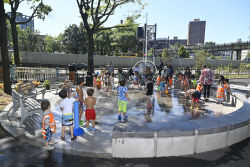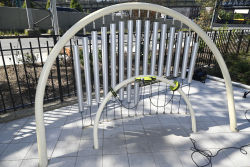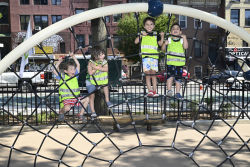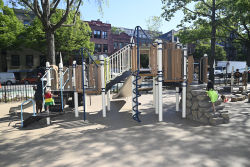La Guardia Playground
La Guardia Playground
What was here before?
The site of this playground was acquired by the City of New York for the creation of the Williamsburg Bridge. The space, along with the adjacent Continental Army Plaza, was cleared in 1903.
How did this site become a playground?
The playground was originally built in 1937 in conjunction with work on the bridge, and the following year the Department of Public Works transferred the site to the City of New York. The playground was further developed in the 1940s and 50s to accommodate the elevated approach to the Brooklyn-Queens Expressway that bisects La Guardia Playground.
The playground was rebuilt and opened in two phases, opening in 2020 and 2022 under NYC Parks’ Community Parks Initiative—a multi-faceted program to invest in under-resourced public parks and increase the accessibility and quality of parks throughout the five boroughs. The new design connects the playground’s two sections through a cohesive design vocabulary using similar materials, site furniture, and plantings across the two playground spaces. Sitting areas and play equipment were also updated.
Who is this playground named for?
This playground honors Mayor Fiorello La Guardia (1882-1947), who served as a United States congressman and for three terms as mayor of New York City. Allied to progressive forces in politics, he fought and won many battles for the poor and disadvantaged. His command of Italian, Yiddish, German, Spanish, and Croatian endeared him to the City’s many immigrant enclaves.
La Guardia, the son of a United States Army bandleader, was born in Little Italy. He attended high school in Prescott, AZ, and held several jobs in the United States and abroad before graduating from the New York University Law School in 1910. By offering free legal aid to immigrants in New York, he established a loyal following that helped get him elected to Congress in 1916, where he would serve as its first Italian-American member.
After a stint in the armed services during World War I, he served as president of the city's Board of Aldermen (1920-1921). Despite being a liberal Republican in staunchly Democratic New York, he served as a congressman until he won the 1933 mayoral election.
Mayor La Guardia was inaugurated on New Year’s Day 1934. Over the next 12 years, La Guardia left a distinctive mark on city politics. He unified the public transit system, consolidated and centralized much of the city government, cracked down on illegal gambling, and constructed numerous bridges and parks. With Robert Moses as his Parks Commissioner, he embarked on an unprecedented expansion of the New York City park system throughout the 1930s and early 1940s, and oversaw the building of health clinics, recreational facilities, and the airport that today bears his name. La Guardia also served as Director of the Office of Civilian Defense from 1941 to 1942. Shortly after leaving office in 1945, La Guardia became Director General of the United Nations Relief and Rehabilitation Administration. He died on Sept. 20, 1947 in New York City.
Check out your park's Vital Signs
Clean & Safe
Green & Resilient
Empowered & Engaged Users
Share your feedback or learn more about how this park is part of a
Vital Park System




